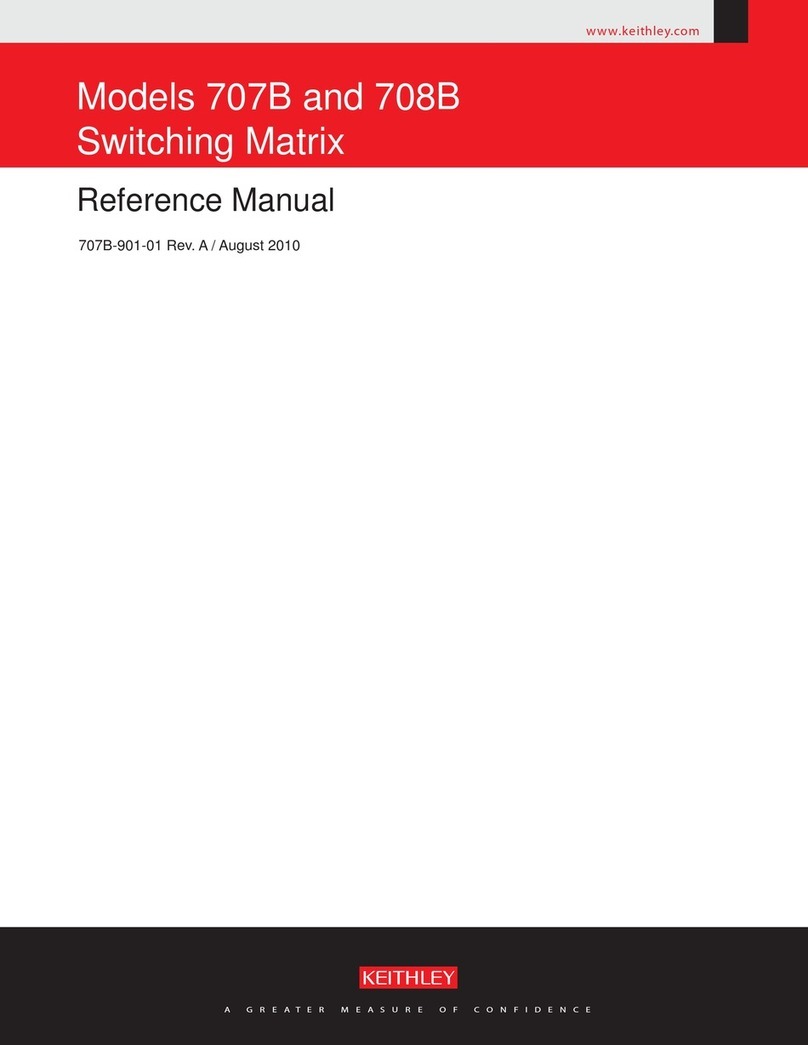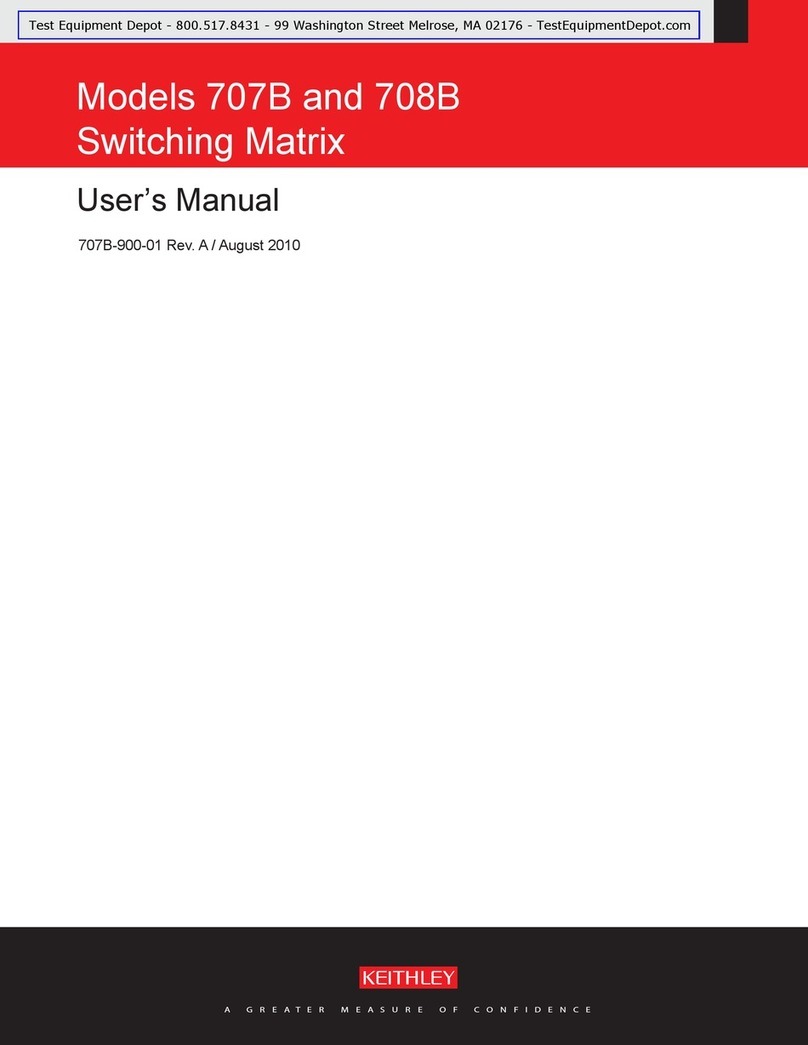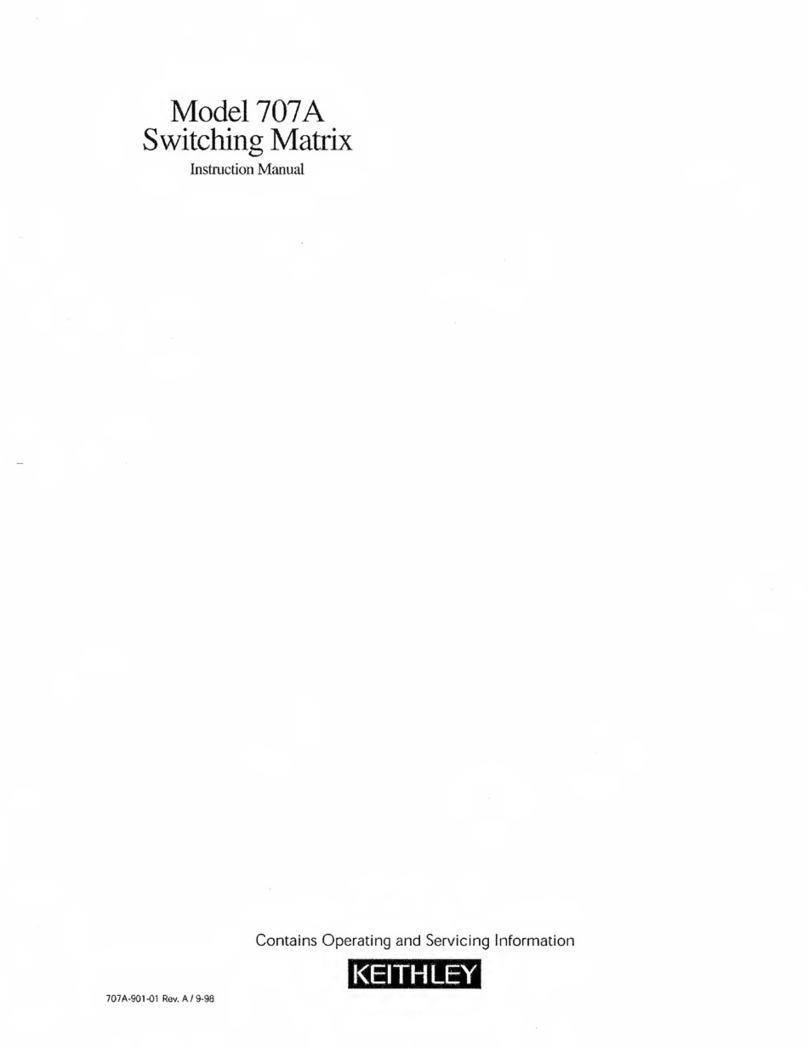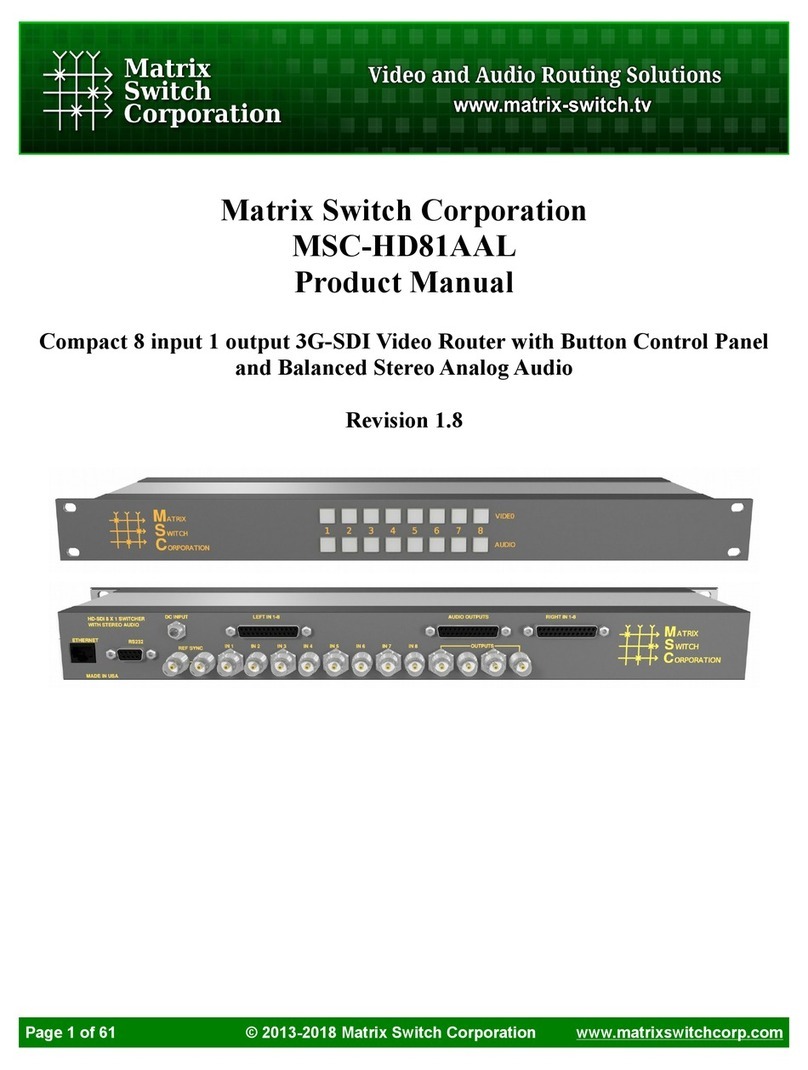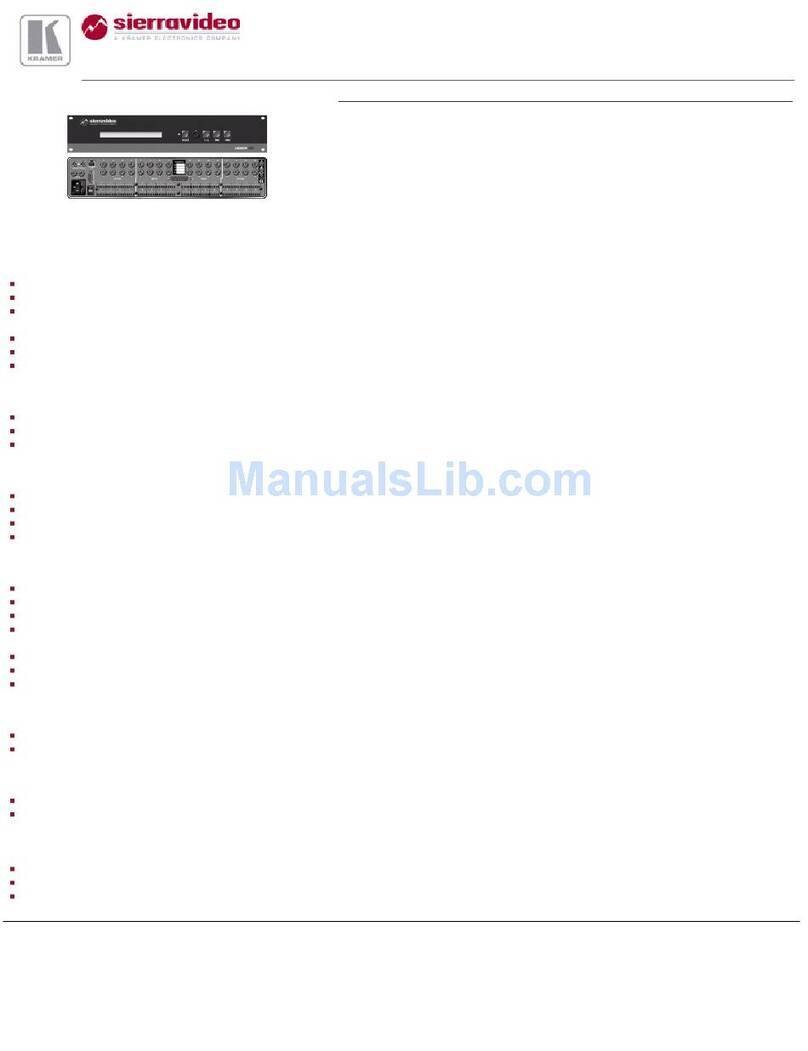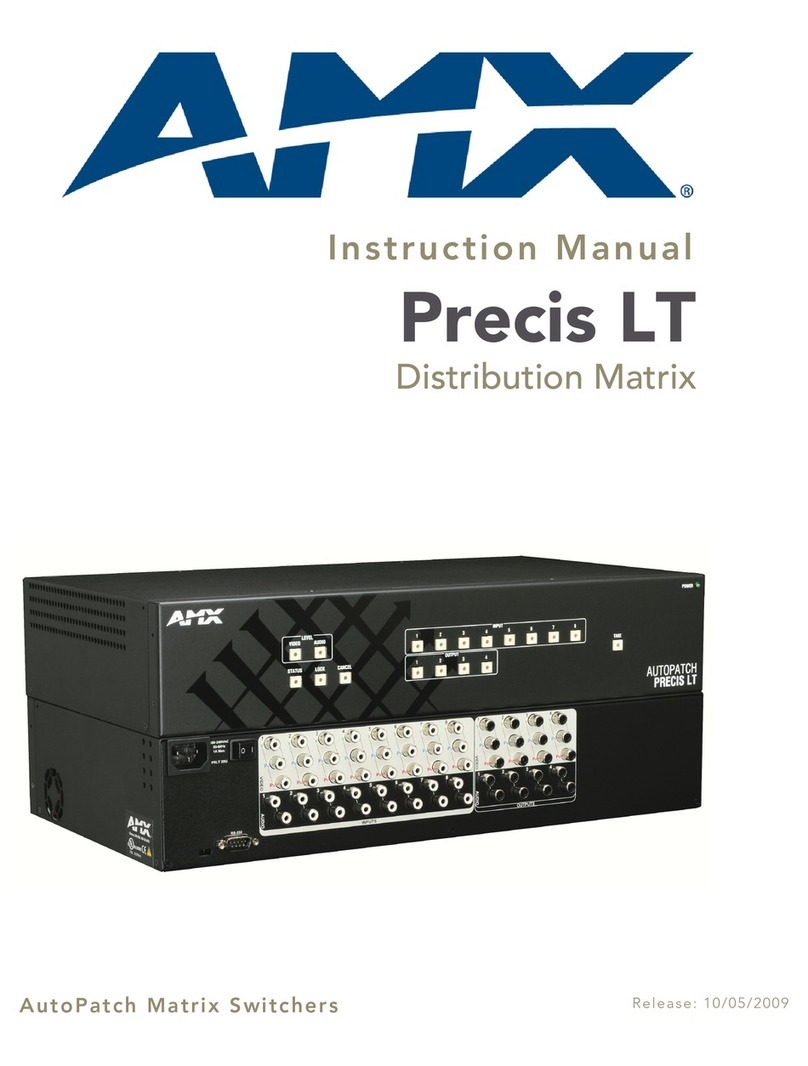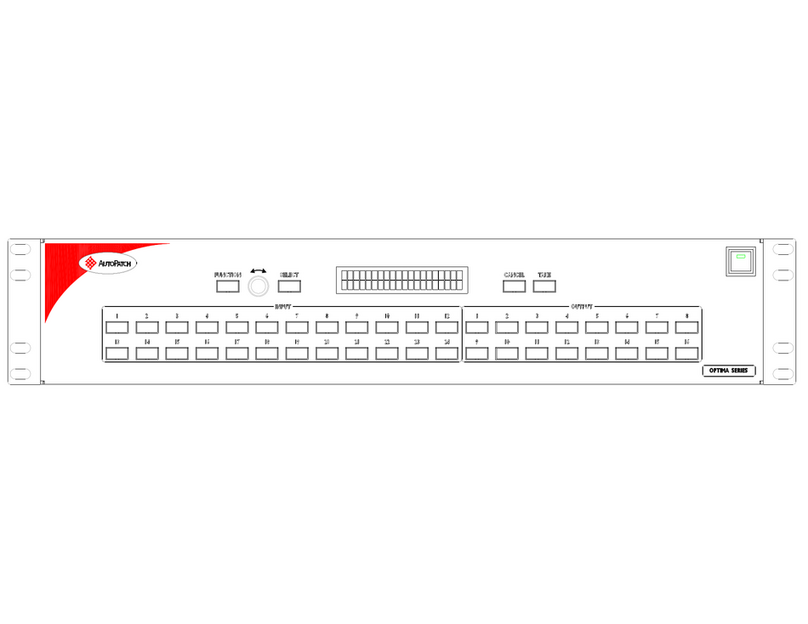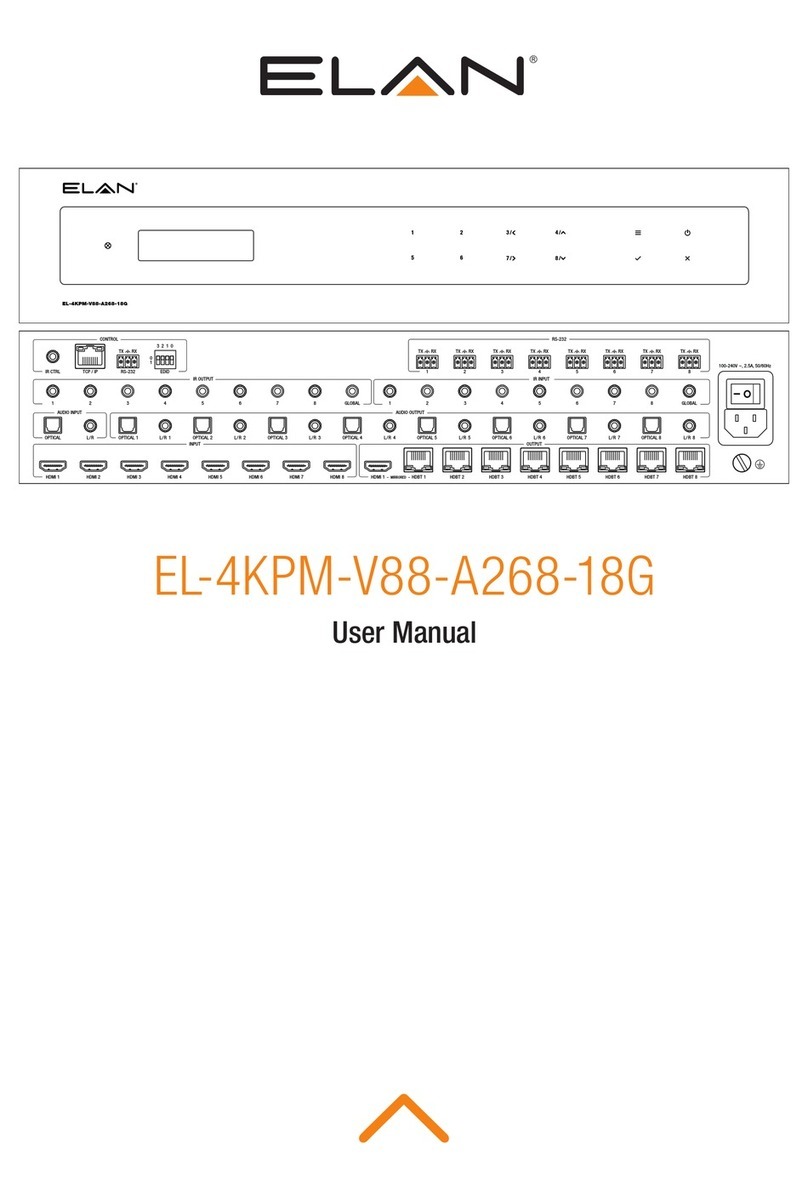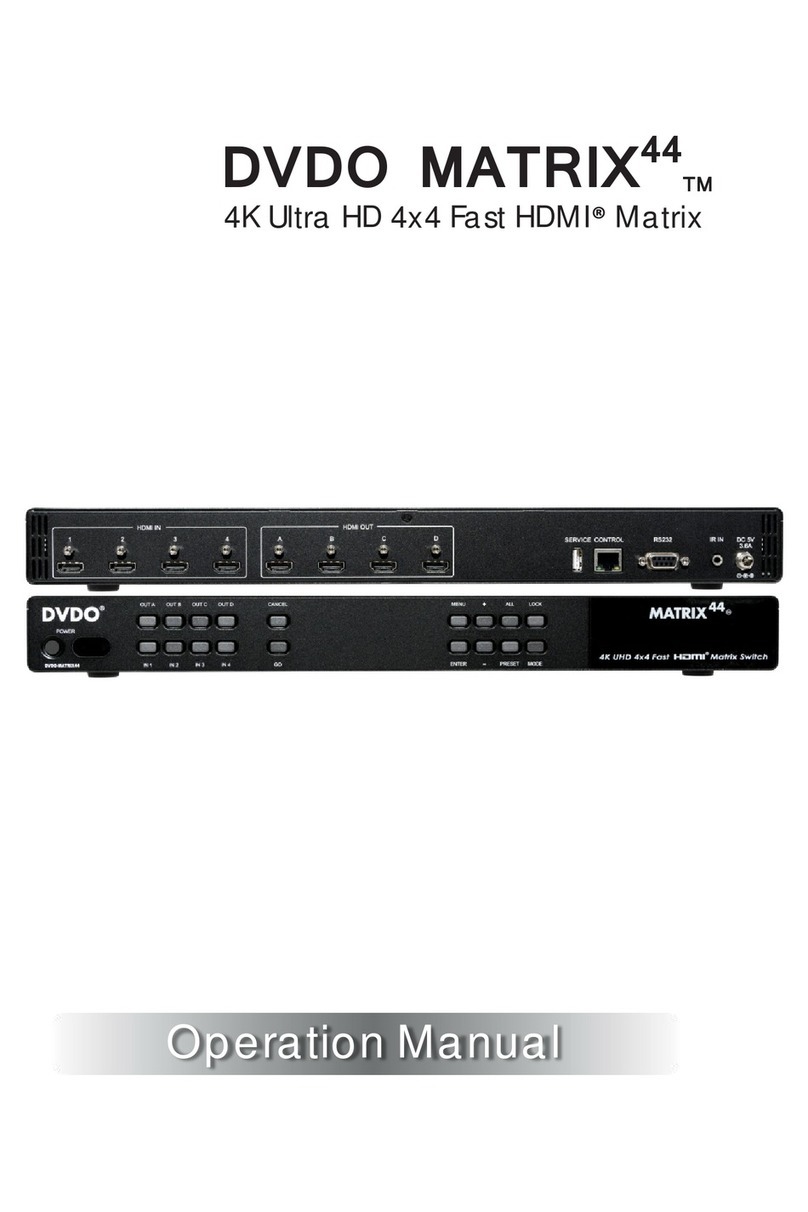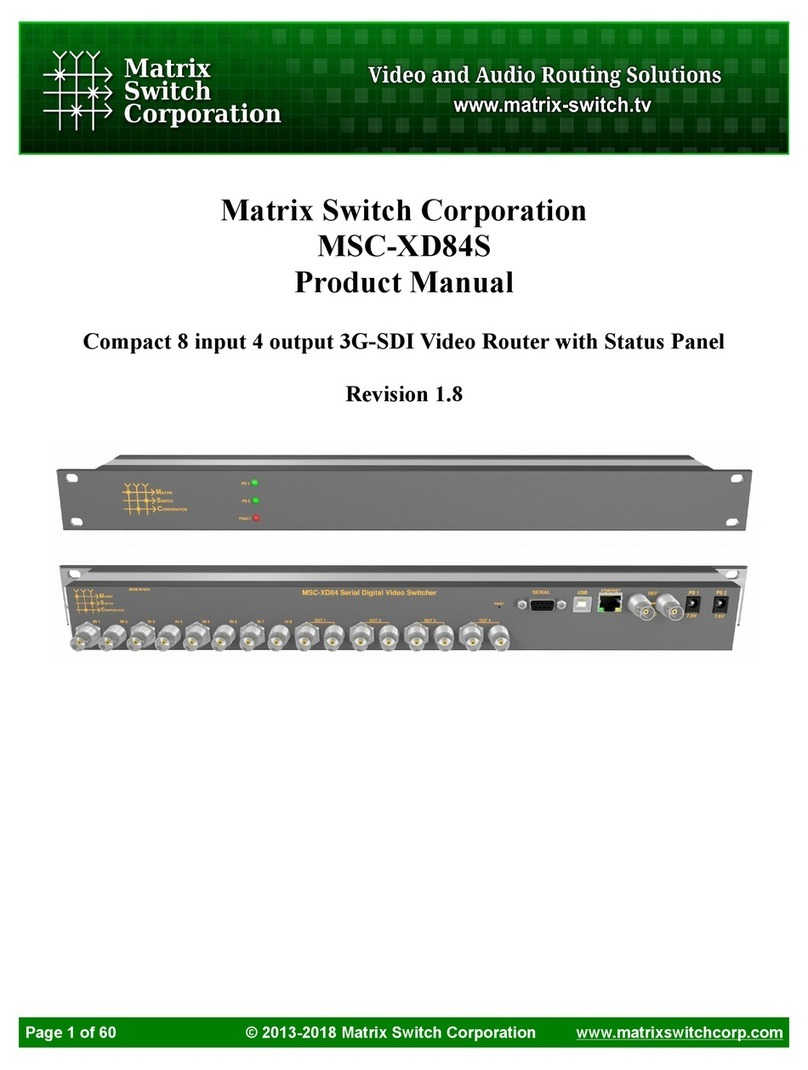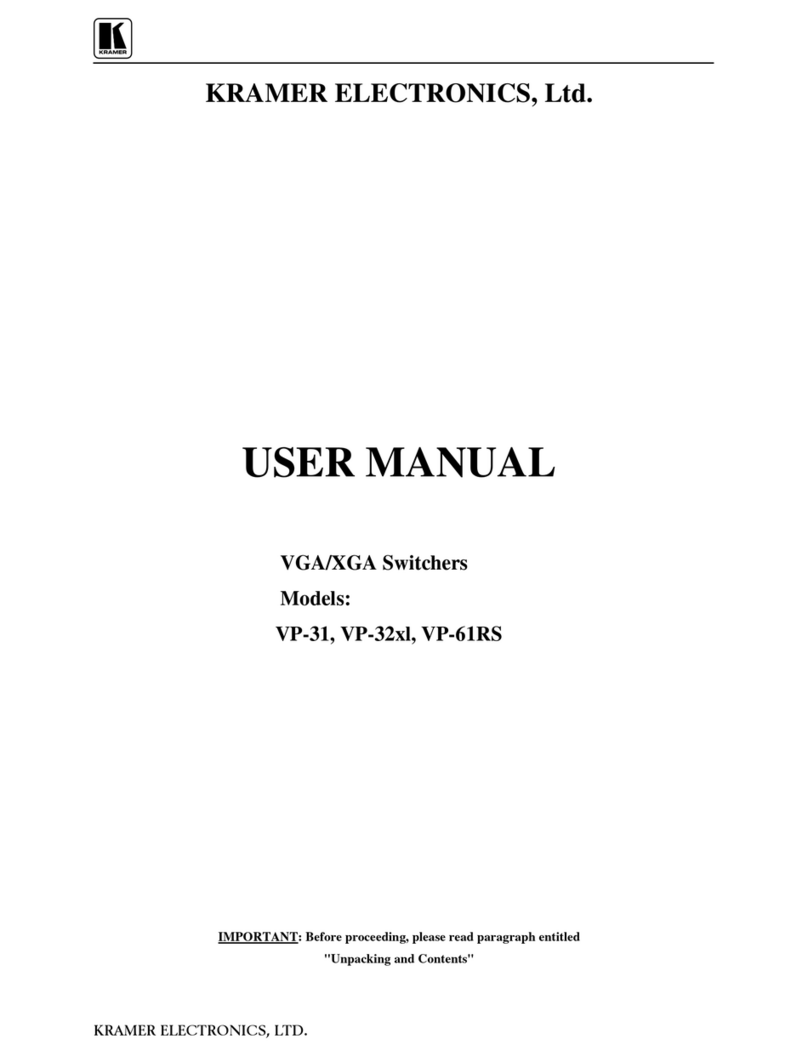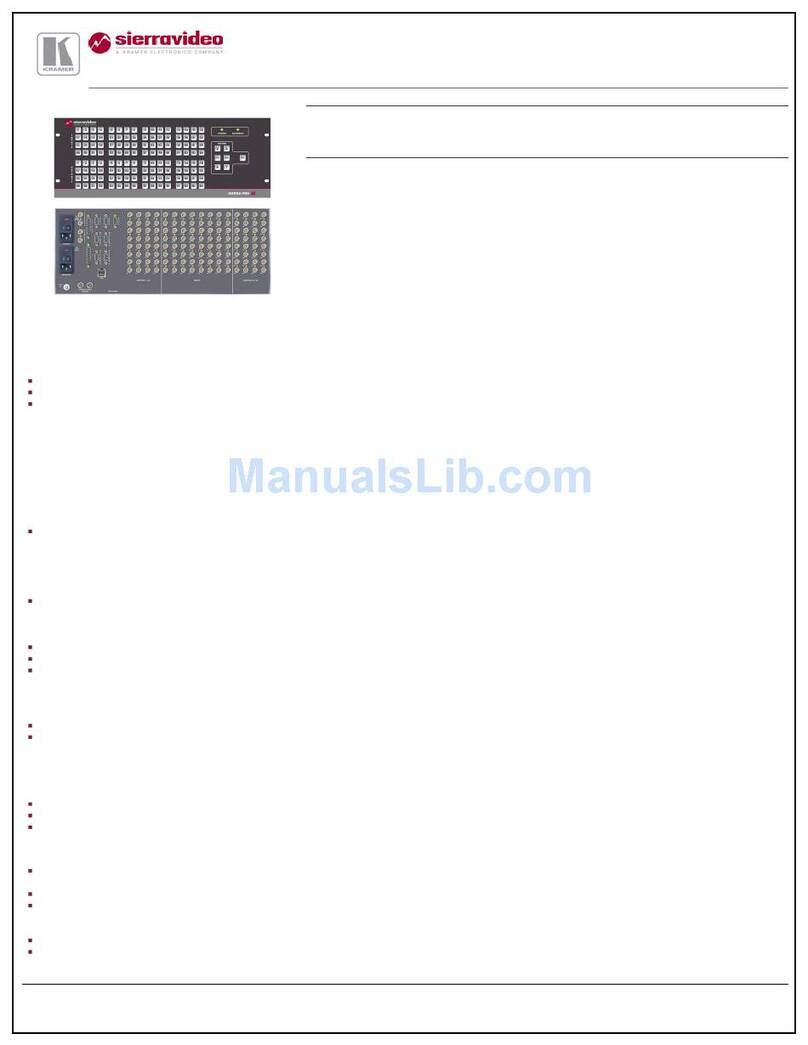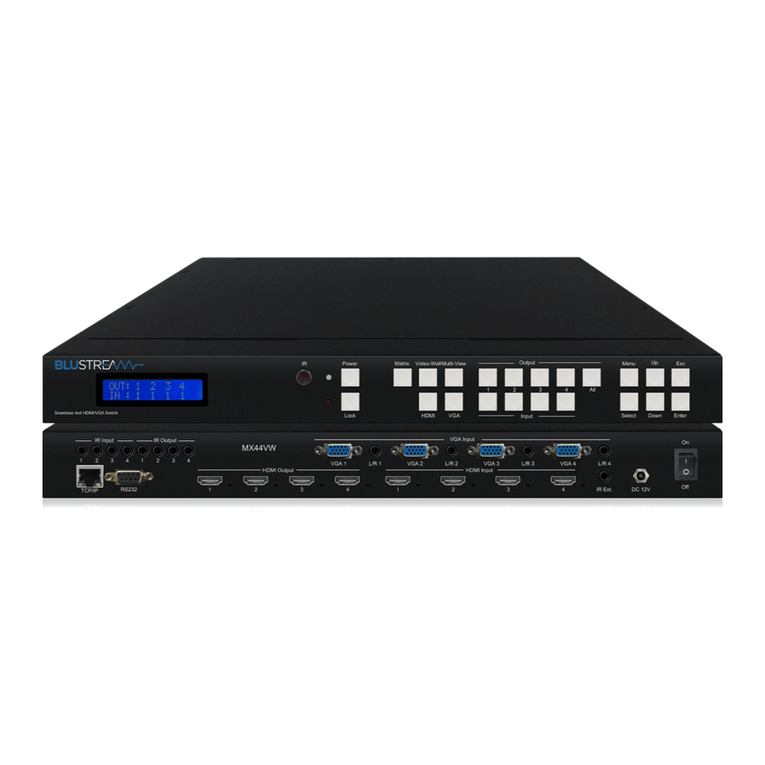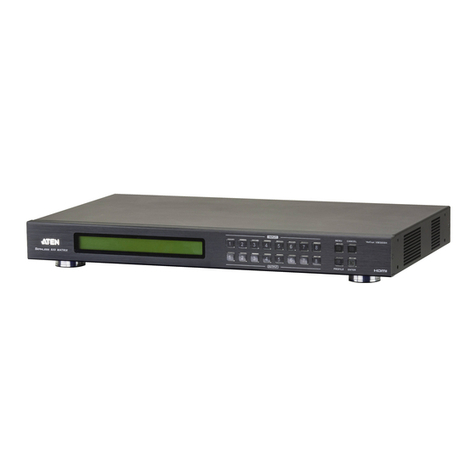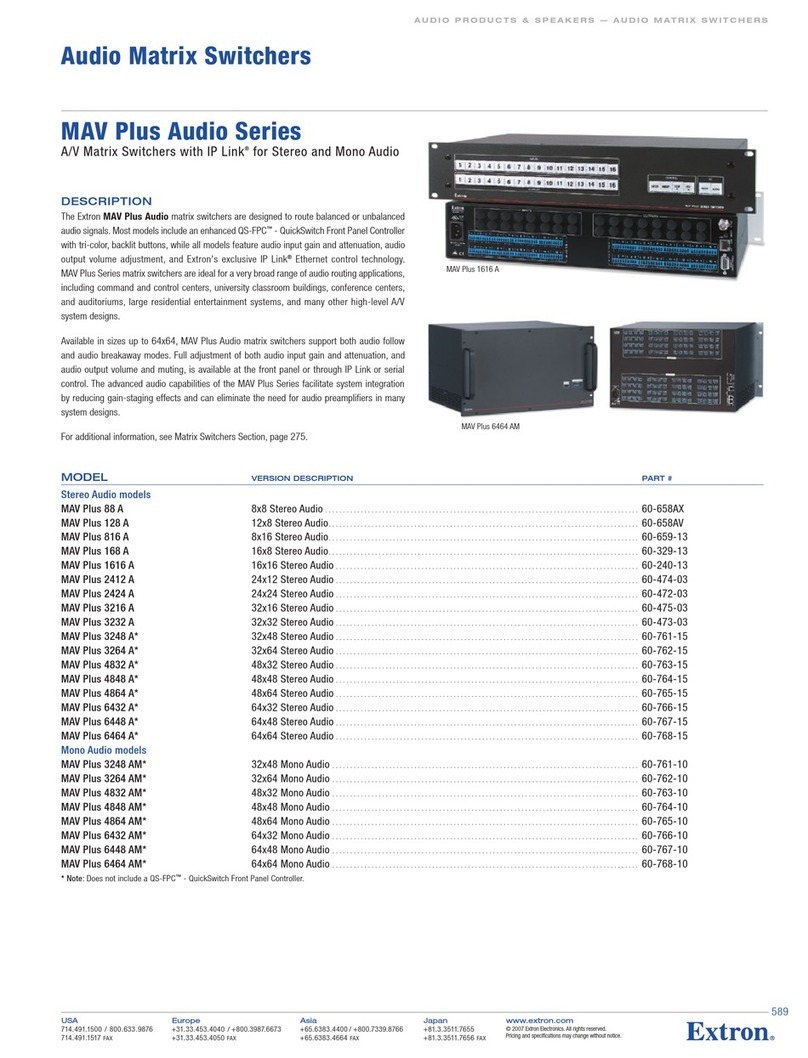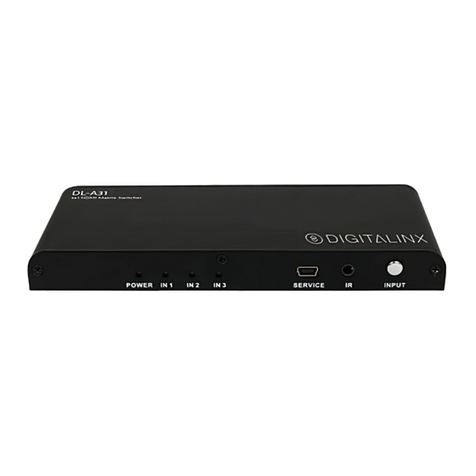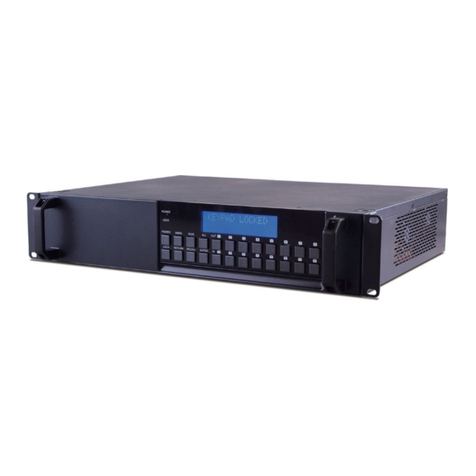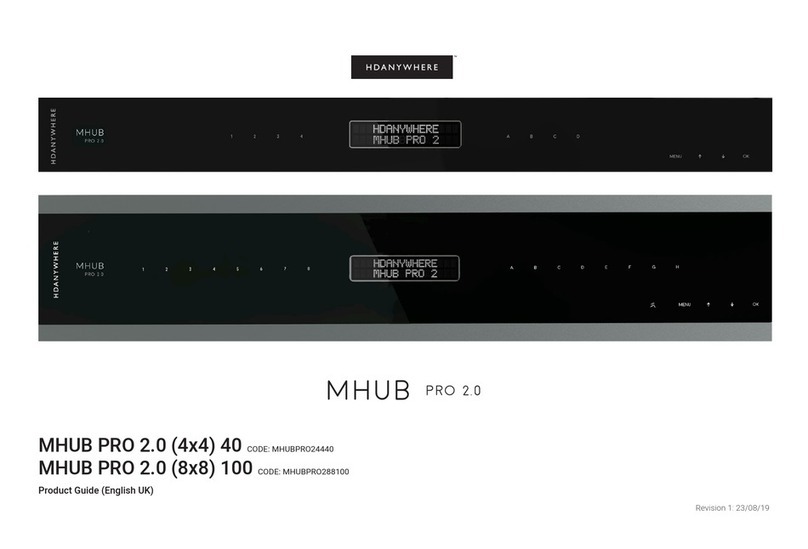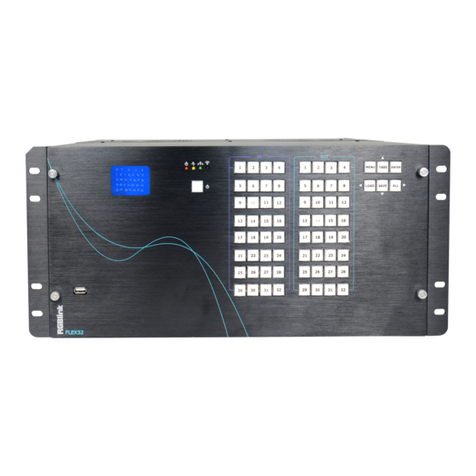Keithley 7172 User manual

-~
ARTISAN
®
~I
TECHNOLOGY
GROUP
Your definitive source
for
quality
pre-owned
equipment.
Artisan Technology
Group
Full-service,
independent
repair
center
with
experienced
engineers
and
technicians
on staff.
We
buy
your
excess,
underutilized,
and
idle
equipment
along
with
credit
for
buybacks
and
trade-ins
.
Custom
engineering
so
your
equipment
works
exactly as
you
specify.
•
Critical
and
expedited
services
•
Leasing
/
Rentals/
Demos
• In
stock/
Ready-to-ship
•
!TAR-certified
secure
asset
solutions
Expert
team
ITrust
guarantee
I
100%
satisfaction
All
tr
ademarks,
br
a
nd
names, a
nd
br
a
nd
s a
pp
earing here
in
are
th
e property of
th
e
ir
r
es
pecti
ve
ow
ner
s.
Find the Keithley 7172 at our website: Click HERE

Model 7172Low Current 8 ×12 Matrix Card
Instruction Manual
A GREATER MEASURE OF CONFIDENCE
Artisan Technology Group - Quality Instrumentation ... Guaranteed | (888) 88-SOURCE | www.artisantg.com

WARRANTY
Keithley Instruments, Inc. warrants this product to be free from defects in material and workmanship for a period of 1 year
from date of shipment.
Keithley Instruments, Inc. warrants the following items for 90 days from the date of shipment: probes, cables, rechargeable
batteries, diskettes, and documentation.
During the warranty period, we will, at our option, either repair or replace any product that proves to be defective.
To exercise this warranty, write or call your local Keithley representative, or contact Keithley headquarters in Cleveland, Ohio.
You will be given prompt assistance and return instructions. Send the product, transportation prepaid, to the indicated service
facility. Repairs will be made and the product returned, transportation prepaid. Repaired or replaced products are warranted for
the balance of the original warranty period, or at least 90 days.
LIMITATION OF WARRANTY
This warranty does not apply to defects resulting from product modification without Keithley’s express written consent, or
misuse of any product or part. This warranty also does not apply to fuses, software, non-rechargeable batteries, damage from
battery leakage, or problems arising from normal wear or failure to follow instructions.
THIS WARRANTY IS IN LIEU OF ALL OTHER WARRANTIES, EXPRESSED OR IMPLIED, INCLUDING ANY
IMPLIED WARRANTY OF MERCHANTABILITY OR FITNESS FOR A PARTICULAR USE. THE REMEDIES PRO-
VIDED HEREIN ARE BUYER’S SOLE AND EXCLUSIVE REMEDIES.
NEITHER KEITHLEY INSTRUMENTS, INC. NOR ANY OF ITS EMPLOYEES SHALL BE LIABLE FOR ANY DIRECT,
INDIRECT, SPECIAL, INCIDENTAL OR CONSEQUENTIAL DAMAGES ARISING OUT OF THE USE OF ITS
INSTRUMENTS AND SOFTWARE EVEN IF KEITHLEY INSTRUMENTS, INC., HAS BEEN ADVISED IN ADVANCE
OF THE POSSIBILITY OF SUCH DAMAGES. SUCH EXCLUDED DAMAGES SHALL INCLUDE, BUT ARE NOT LIM-
ITED TO: COSTS OF REMOVAL AND INSTALLATION, LOSSES SUSTAINED AS THE RESULT OF INJURY TO ANY
PERSON, OR DAMAGE TO PROPERTY.
Keithley Instruments, Inc.
28775 Aurora Road • Cleveland, Ohio 44139 • 440-248-0400 • Fax: 440-248-6168
1-888-KEITHLEY (534-8453) • www.keithley.com
Sales Offices: BELGIUM: Bergensesteenweg 709 • B-1600 Sint-Pieters-Leeuw • 02-363 00 40 • Fax: 02/363 00 64
CHINA: Yuan Chen Xin Building, Room 705 • 12Yumin Road, Dewai, Madian • Beijing 100029 • 8610-6202-2886 • Fax: 8610-6202-2892
FINLAND: Tietäjäntie 2 • 02130 Espoo • Phone: 09-54 75 08 10 • Fax: 09-25 10 51 00
FRANCE: 3, allée des Garays • 91127 Palaiseau Cédex • 01-64 53 20 20 • Fax: 01-60 11 77 26
GERMANY: Landsberger Strasse 65 • 82110 Germering • 089/84 93 07-40 • Fax: 089/84 93 07-34
GREAT BRITAIN: Unit 2 Commerce Park, Brunel Road • Theale • Berkshire RG7 4AB • 0118 929 7500 • Fax: 0118 929 7519
INDIA: Flat 2B, Willocrissa • 14, Rest House Crescent • Bangalore 560 001 • 91-80-509-1320/21 • Fax: 91-80-509-1322
ITALY: Viale San Gimignano, 38 • 20146 Milano • 02-48 39 16 01 • Fax: 02-48 30 22 74
KOREA: FL., URI Building • 2-14Yangjae-Dong • Seocho-Gu, Seoul 137-130 • 82-2-574-7778 • Fax: 82-2-574-7838
NETHERLANDS: Postbus 559 • 4200AN Gorinchem • 0183-635333 • Fax: 0183-630821
SWEDEN: c/o Regus Business Centre • Frosundaviks Allé 15, 4tr • 169 70 Solna • 08-509 04 679 • Fax: 08-655 26 10
SWITZERLAND: Kriesbachstrasse 4 • 8600 Dübendorf • 01-821 94 44 • Fax: 01-820 30 81
TAIWAN: 1FL., 85 Po Ai Street • Hsinchu, Taiwan, R.O.C. • 886-3-572-9077• Fax: 886-3-572-9031
© Copyright 2001 Keithley Instruments, Inc.
Printed in the U.S.A.
11/01
Artisan Technology Group - Quality Instrumentation ... Guaranteed | (888) 88-SOURCE | www.artisantg.com

Model 7172
Low Current 8
×
12 Matrix Card
Instruction Manual
©1991, Keithley Instruments, Inc.
All rights reserved.
Cleveland, Ohio, U.S.A.
Document Number: 7172-901-01 Rev. C
Artisan Technology Group - Quality Instrumentation ... Guaranteed | (888) 88-SOURCE | www.artisantg.com

SAFETY PRECAUTIONS
The following safety precautions should be observed before using the Model 7172 and the associated instruments.
This matrix card is intended for use by qualified personnel who recognize shock hazards and are familiar with the safety
precautions required to avoid possible injury. Read over this manual carefully before using the mati card.
Exercise extreme caution when ashock hazard is present at the test circuit. User-supplied lethal voltages may be present
on the card connector jacks. The American National Standards Institute (ANSI) states that a shock hazard exists when
voltage levels greater than 3OVRM!? or 42.4V peak are present. A good safety practice is to expect that hazardous voltage
is present in any unknown circuit before measuring.
Do not exceed 200V between any two pins or between any pin and chassis.
Inspect the connecting cables and test leads for possible wear, cracks, or breaks before each use.
For maximum safety, do not touch the test cables or any instruments while power is applied to the circuit under test.
Turn off the power and discharge any capacitors before connecting or disconnecting cables from the matrix card.
Do not touch any object which could provide a current path to the common side of the circuit under test or power line
(earth) ground. Always make measurements with dry hands while standing on a dry, insulated surface capable of with-
standing the voltage being measured.
Do not exceed the maximum allowable input of the matrix card, asdefined in the specifications and operation section of
this manual.
Instrumentation and accessories should not be connected to humans
Artisan Technology Group - Quality Instrumentation ... Guaranteed | (888) 88-SOURCE | www.artisantg.com

Safety Precautions
The following safety precautions should be observed before using
this product and any associated instrumentation.Although some in-
struments and accessories would normally be used with non-haz-
ardous voltages, there are situations where hazardous conditions
may be present.
This product is intended for use by qualified personnel who recog-
nize shock hazards and are familiar with the safety precautions re-
quired to avoid possible injury. Read and follow all installation,
operation, and maintenance information carefully before using the
product. Refer to the manual for complete product specifications.
If the product is used in a manner not specified, the protection pro-
vided by the product may be impaired.
The types of product users are:
Responsible body
is the individual or group responsible for the use
and maintenance of equipment, for ensuring that the equipment is
operated within its specifications and operating limits, and for en-
suring that operators are adequately trained.
Operators
use the product for its intended function. They must be
trained in electrical safety procedures and proper use of the instru-
ment. They must be protected from electric shock and contact with
hazardous live circuits.
Maintenancepersonnel
perform routine procedures on the product
to keep it operating properly, for example, setting the line voltage
or replacing consumable materials. Maintenance procedures are de-
scribed in the manual. The procedures explicitly state if the operator
may perform them. Otherwise, they should be performed only by
service personnel.
Service personnel
are trained to work on live circuits, and perform
safe installations and repairs of products. Only properly trained ser-
vice personnel may perform installation and service procedures.
Keithley products are designed for use with electrical signals that
are rated Installation Category I and Installation Category II, as de-
scribed in the International Electrotechnical Commission (IEC)
Standard IEC 60664. Most measurement, control, and data I/O sig-
nals are Installation Category I and must not be directly connected
to mains voltage or to voltage sources with high transient over-volt-
ages. Installation Category II connections require protection for
high transient over-voltages often associated with local AC mains
connections. Assume all measurement, control, and data I/O con-
nections are for connection to Category I sources unless otherwise
marked or described in the Manual.
Exercise extreme caution when a shock hazard is present. Lethal
voltage may be present on cable connector jacks or test fixtures.The
American National Standards Institute (ANSI) states that a shock
hazard exists when voltage levels greater than 30V RMS, 42.4V
peak, or 60VDC are present.
A good safety practice is to expect
that hazardous voltage is present in any unknown circuit before
measuring.
Operators of this product must be protected from electric shock at
all times. The responsible body must ensure that operators are pre-
vented access and/or insulated from every connection point. In
some cases, connections must be exposed to potential human con-
tact. Product operators in these circumstances must be trained to
protect themselves from the risk of electric shock. If the circuit is
capable of operating at or above 1000 volts,
no conductive part of
the circuit may be exposed.
Do not connect switching cards directly to unlimited power circuits.
They are intended to be used with impedance limited sources.
NEVER connect switching cards directly to AC mains. When con-
necting sources to switching cards, install protective devices to lim-
it fault current and voltage to the card.
Before operating an instrument, make sure the line cord is connect-
ed to a properly grounded power receptacle. Inspect the connecting
cables, test leads, and jumpers for possible wear, cracks, or breaks
before each use.
When installing equipment where access to the main power cord is
restricted, such as rack mounting, a separate main input power dis-
connect device must be provided, in close proximity to the equip-
ment and within easy reach of the operator.
For maximum safety, do not touch the product, test cables, or any
other instruments while power is applied to the circuit under test.
ALWAYS remove power from the entire test system and discharge
any capacitors before: connecting or disconnecting cables or jump-
ers, installing or removing switching cards, or making internal
changes, such as installing or removing jumpers.
Do not touch any object that could provide a current path to the com-
mon side of the circuit under test or power line (earth) ground.Always
make measurements with dry hands while standing on a dry, insulated
surface capable of withstanding the voltage being measured.
The instrument and accessories must be used in accordance with its
specifications and operating instructions or the safety of the equip-
ment may be impaired.
Do not exceed the maximum signal levels of the instruments and ac-
cessories, as defined in the specifications and operating informa-
tion, and as shown on the instrument or test fixture panels, or
switching card.
When fuses are used in a product, replace with same type and rating
for continued protection against fire hazard.
Chassis connections must only be used as shield connections for
measuring circuits, NOT as safety earth ground connections.
If you are using a test fixture, keep the lid closed while power is ap-
plied to the device under test. Safe operation requires the use of a
lid interlock.
Artisan Technology Group - Quality Instrumentation ... Guaranteed | (888) 88-SOURCE | www.artisantg.com

If a screw is present, connect it to safety earth ground using the
wire recommended in the user documentation.
The symbol on an instrument indicates that the user should re-
fer to the operating instructions located in the manual.
The symbol on an instrument shows that it can source or mea-
sure 1000 volts or more, including the combined effect of normal
and common mode voltages. Use standard safety precautions to
avoid personal contact with these voltages.
The
WARNING
heading in a manual explains dangers that might
result in personal injury or death.Always read the associated infor-
mation very carefully before performing the indicated procedure.
The
CAUTION
heading in a manual explains hazards that could
damage the instrument. Such damage may invalidate the warranty.
Instrumentation and accessories shall not be connected to humans.
Before performing any maintenance, disconnect the line cord and
all test cables.
To maintain protection from electric shock and fire, replacement
components in mains circuits, including the power transformer, test
leads, and input jacks, must be purchased from Keithley Instru-
ments. Standard fuses, with applicable national safety approvals,
may be used if the rating and type are the same. Other components
that are not safety related may be purchased from other suppliers as
long as they are equivalent to the original component. (Note that se-
lected parts should be purchased only through Keithley Instruments
to maintain accuracy and functionality of the product.) If you are
unsure about the applicability of a replacement component, call a
Keithley Instruments office for information.
To clean an instrument, use a damp cloth or mild, water based
cleaner. Clean the exterior of the instrument only. Do not apply
cleaner directly to the instrument or allow liquids to enter or spill
on the instrument. Products that consist of a circuit board with no
case or chassis (e.g., data acquisition board for installation into a
computer) should never require cleaning if handled according to in-
structions. If the board becomes contaminated and operation is af-
fected, the board should be returned to the factory for proper
cleaning/servicing.
!
11/01
Artisan Technology Group - Quality Instrumentation ... Guaranteed | (888) 88-SOURCE | www.artisantg.com

7172 8×12 Low Current Matrix Card
2
2
2
2
2
2
2
2
2
2
2
2
2
2
2
2
2
2
2
2
2
2
2
2
2
2
2
2
2
2
2
2
2
2
2
2
2
2
2
2
2
2
2
2
2
2
2
2
2
2
2
2
2
2
2
2
2
2
2
2
2
2
2
2
2
2
2
2
2
2
2
2
2
2
2
2
2
2
2
2
2
2
2
2
2
2
2
2
2
2
2
2
2
2
2
2
2
2
2
2
2
2
2
2
2
2
2
2
2
2
2
2
2
2
2
2
2
2
2
2
2
2
2
2
2
2
2
2
2
2
2
2
2
2
2
2
2
2
2
2
2
2
2
2
2
22
22
22
22
22
22
22
22
22
22
22
2
2
22
22
22
22
22
22
22
22
22
22
22
2
HGCHGCHGCHGCHGCHGCHGCHGCHGCHGCHGCHGC
H
G
C
H
G
C
H
G
C
H
G
C
H
G
C
H
G
C
H
G
C
H
G
C
Columns
Rows
User
connections
and expansion
Offset current
self test
MATRIX CONFIGURATION: Single 8 rows×12 columns. Expanding
the columns can be done internally by connecting the rows of mul-
tiple 7172 cards together with coax jumpers.
OFFSET CURRENT SELF TEST: An onboard electrometer circuit
measures offset current when the rear panel switch is pushed.
Pass/fail LEDs indicate if offset is above or below 500fA. The on-
board SMB connector outputs voltage proportional to current
(1mV/10fA).
CROSSPOINT CONFIGURATION: 2-pole Form A (Signal, Guard).
CONNECTOR TYPE: 3-lug triax (Signal, Guard, Chassis).
MAXIMUM SIGNAL LEVEL: Pin to pin or pin to chassis: 200V. 1A
carry/0.5A switched, 10VA.
CONTACT LIFE: Cold Switching: 108closures. At Maximum Signal
Level: 105closures.
PATH RESISTANCE (Per Conductor): <1.0Ωinitial, <1.5Ωat end of
contact life.
CONTACT POTENTIAL: Differential (Signal to Guard): <30µV.
Single ended (Guard to Guard or Signal to Signal): <60µV.
OFFSET CURRENT: <500fA, 150fA typical.
ISOLATION:
Path (Signal to Signal): >1013Ω, 0.4pF typical.
Differential (Signal to Guard): >109Ω, 170pF typical.
Common (Signal and Guard to Chassis): >109Ω, 430pF typical.
CROSSTALK (1MHz, 50ΩLoad): <–70dB.
INSERTION LOSS (1MHz, 50ΩLoad): 0.22dB typical.
3dB BANDWIDTH (50ΩLoad, 50ΩSource): 30MHz typical.
RELAY DRIVE CURRENT (Per Crosspoint): 30mA.
RELAY SETTLING TIME: <2ms.
EMC: Conforms to European Union Directive 89/336/EEC.
SAFETY: Conforms to European Union Directive 73/23/EEC (meets
EN61010-1/IEC 1010).
ENVIRONMENT:
Offset Current and Path Isolation Specifications: 23°C,
<50% R.H.
Operating: 0° to 50°C, up to 35°C at 70% R.H.
Storage: –25° to +65°C.
ACCESSORY SUPPLIED: Instruction manual and eight SMB expan-
sion cables (C99-1A).
Artisan Technology Group - Quality Instrumentation ... Guaranteed | (888) 88-SOURCE | www.artisantg.com

Contains information on Model 7172 features, specifica-
tions, and accessories.
SECTION 1
General Information
Details installation of the Model 7172 Low Current 8 x 12
Matrix Card within the Model 707 Switching Matrix, cov-
ers card connections, and also discusses measurement
considerations.
Gives four typical applications for the Model 7172, includ-
ing combined quasistatic and high-frequency CV meas-
urements, van der Pauw resistivity measurements, and
semiconductor parameter analysis.
SECTION 3
Applications
Contains performance verification procedures, trouble-
shooting information and principles of operation for the
matrix card.
SECTION 4
Service Information
Lists replacement parts, and also includes component lay-
out and schematic drawings for the Model 7172.
SECTION 5
Replaceable Parts
Artisan Technology Group - Quality Instrumentation ... Guaranteed | (888) 88-SOURCE | www.artisantg.com

Table of Contents
SECTION 1 —
General Information
1.1 INTRODUCTION . . . . . . . . . . . . . . . . . . . . . . . . . . . . . . . . . . . . . . . . . . . . . . . . . . . . . . . . . . . . . . . . . . . . 1-1
1.2 FEATURES . . . . . . . . . . . . . . . . . . . . . . . . . . . . . . . . . . . . . . . . . . . . . . . . . . . . . . . . . . . . . . . . . . . . . . . . . . 1-1
1.3 WARRANTY INFORMATION . . . . . . . . . . . . . . . . . . . . . . . . . . . . . . . . . . . . . . . . . . . . . . . . . . . . . . . . . 1-1
1.4 MANUAL ADDENDA . . . . . . . . . . . . . . . . . . . . . . . . . . . . . . . . . . . . . . . . . . . . . . . . . . . . . . . . . . . . . . . . 1-1
1.5 SAFETY SYMBOLS AND TERMS . . . . . . . . . . . . . . . . . . . . . . . . . . . . . . . . . . . . . . . . . . . . . . . . . . . . . . . 1-1
1.6 SPECIFICATIONS . . . . . . . . . . . . . . . . . . . . . . . . . . . . . . . . . . . . . . . . . . . . . . . . . . . . . . . . . . . . . . . . . . . . 1-2
1.7 UNPACKING AND INSPECTION. . . . . . . . . . . . . . . . . . . . . . . . . . . . . . . . . . . . . . . . . . . . . . . . . . . . . . 1-2
1.7.1 Inspection for Damage. . . . . . . . . . . . . . . . . . . . . . . . . . . . . . . . . . . . . . . . . . . . . . . . . . . . . . . . . . . . . . . 1-2
1.7.2 Shipment Contents. . . . . . . . . . . . . . . . . . . . . . . . . . . . . . . . . . . . . . . . . . . . . . . . . . . . . . . . . . . . . . . . . . 1-2
1.7.3 Instrument Manual. . . . . . . . . . . . . . . . . . . . . . . . . . . . . . . . . . . . . . . . . . . . . . . . . . . . . . . . . . . . . . . . . . 1-2
1.8 REPACKING FOR SHIPMENT . . . . . . . . . . . . . . . . . . . . . . . . . . . . . . . . . . . . . . . . . . . . . . . . . . . . . . . . . 1-2
1.9 OPTIONAL ACCESSORIES. . . . . . . . . . . . . . . . . . . . . . . . . . . . . . . . . . . . . . . . . . . . . . . . . . . . . . . . . . . . 1-2
1.10 COAXIAL JUMPER ACCESS. . . . . . . . . . . . . . . . . . . . . . . . . . . . . . . . . . . . . . . . . . . . . . . . . . . . . . . . . . . 1-3
SECTION 2 —
Operation
2.1 INTRODUCTION . . . . . . . . . . . . . . . . . . . . . . . . . . . . . . . . . . . . . . . . . . . . . . . . . . . . . . . . . . . . . . . . . . . . 2-1
2.2 HANDLING PRECAUTIONS . . . . . . . . . . . . . . . . . . . . . . . . . . . . . . . . . . . . . . . . . . . . . . . . . . . . . . . . . . 2-1
2.3 ENVIRONMENTAL CONSIDERATIONS . . . . . . . . . . . . . . . . . . . . . . . . . . . . . . . . . . . . . . . . . . . . . . . 2-1
2.4 CARD INSTALLATION AND REMOVAL . . . . . . . . . . . . . . . . . . . . . . . . . . . . . . . . . . . . . . . . . . . . . . . 2-1
2.5 CONNECTIONS . . . . . . . . . . . . . . . . . . . . . . . . . . . . . . . . . . . . . . . . . . . . . . . . . . . . . . . . . . . . . . . . . . . . . 2-3
2.5.1 Card Connectors . . . . . . . . . . . . . . . . . . . . . . . . . . . . . . . . . . . . . . . . . . . . . . . . . . . . . . . . . . . . . . . . . . . . 2-3
2.5.2 Recommended Cables and Adapters . . . . . . . . . . . . . . . . . . . . . . . . . . . . . . . . . . . . . . . . . . . . . . . . . . 2-3
2.5.3 Triaxial to Banana Plug Adapter . . . . . . . . . . . . . . . . . . . . . . . . . . . . . . . . . . . . . . . . . . . . . . . . . . . . . . 2-3
2.5.4 General Instrument Connections . . . . . . . . . . . . . . . . . . . . . . . . . . . . . . . . . . . . . . . . . . . . . . . . . . . . . . 2-5
2.5.5 Keithley Instrument Connections . . . . . . . . . . . . . . . . . . . . . . . . . . . . . . . . . . . . . . . . . . . . . . . . . . . . . 2-11
2.5.6 Typical Test Fixture Connections . . . . . . . . . . . . . . . . . . . . . . . . . . . . . . . . . . . . . . . . . . . . . . . . . . . . . . 2-17
2.6 MATRIX CONFIGURATION . . . . . . . . . . . . . . . . . . . . . . . . . . . . . . . . . . . . . . . . . . . . . . . . . . . . . . . . . . 2-18
2.6.1 Switching Matrix . . . . . . . . . . . . . . . . . . . . . . . . . . . . . . . . . . . . . . . . . . . . . . . . . . . . . . . . . . . . . . . . . . . 2-18
2.6.2 Row Isolators. . . . . . . . . . . . . . . . . . . . . . . . . . . . . . . . . . . . . . . . . . . . . . . . . . . . . . . . . . . . . . . . . . . . . . . 2-20
2.6.3 Internal Matrix Expansion . . . . . . . . . . . . . . . . . . . . . . . . . . . . . . . . . . . . . . . . . . . . . . . . . . . . . . . . . . . 2-20
2.6.4 External Matrix Expansion . . . . . . . . . . . . . . . . . . . . . . . . . . . . . . . . . . . . . . . . . . . . . . . . . . . . . . . . . . . 2-23
2.7 MEASUREMENT CONSIDERATIONS . . . . . . . . . . . . . . . . . . . . . . . . . . . . . . . . . . . . . . . . . . . . . . . . . . 2-24
2.7.1 Magnetic Fields. . . . . . . . . . . . . . . . . . . . . . . . . . . . . . . . . . . . . . . . . . . . . . . . . . . . . . . . . . . . . . . . . . . . . 2-24
2.7.2 Electromagnetic Interference (EMI). . . . . . . . . . . . . . . . . . . . . . . . . . . . . . . . . . . . . . . . . . . . . . . . . . . . 2-25
2.7.3 Ground Loops . . . . . . . . . . . . . . . . . . . . . . . . . . . . . . . . . . . . . . . . . . . . . . . . . . . . . . . . . . . . . . . . . . . . . . 2-25
2.7.4 Keeping Connectors Clean . . . . . . . . . . . . . . . . . . . . . . . . . . . . . . . . . . . . . . . . . . . . . . . . . . . . . . . . . . . 2-25
2.7.5 Noise Currents Caused by Cable Flexing . . . . . . . . . . . . . . . . . . . . . . . . . . . . . . . . . . . . . . . . . . . . . . . 2-26
2.7.6 Shielding . . . . . . . . . . . . . . . . . . . . . . . . . . . . . . . . . . . . . . . . . . . . . . . . . . . . . . . . . . . . . . . . . . . . . . . . . . 2-26
2.7.7 Guarding . . . . . . . . . . . . . . . . . . . . . . . . . . . . . . . . . . . . . . . . . . . . . . . . . . . . . . . . . . . . . . . . . . . . . . . . . . 2-28
2.7.8 Matrix Expansion Effects on Card SpeciÞcations . . . . . . . . . . . . . . . . . . . . . . . . . . . . . . . . . . . . . . . . 2-29
Artisan Technology Group - Quality Instrumentation ... Guaranteed | (888) 88-SOURCE | www.artisantg.com

SECTION 3 —
Applications
3.1 INTRODUCTION . . . . . . . . . . . . . . . . . . . . . . . . . . . . . . . . . . . . . . . . . . . . . . . . . . . . . . . . . . . . . . . . . . . . . 3-1
3.2 CV MEASUREMENTS . . . . . . . . . . . . . . . . . . . . . . . . . . . . . . . . . . . . . . . . . . . . . . . . . . . . . . . . . . . . . . . . . 3-1
3.2.1 Stand Alone System ConÞguration . . . . . . . . . . . . . . . . . . . . . . . . . . . . . . . . . . . . . . . . . . . . . . . . . . . . . 3-1
3.2.2 Computerized System ConÞguration. . . . . . . . . . . . . . . . . . . . . . . . . . . . . . . . . . . . . . . . . . . . . . . . . . . 3-1
3.2.3 Optimizing CV Measurement Accuracy. . . . . . . . . . . . . . . . . . . . . . . . . . . . . . . . . . . . . . . . . . . . . . . . . 3-4
3.2.4 Basic CV Test Procedure . . . . . . . . . . . . . . . . . . . . . . . . . . . . . . . . . . . . . . . . . . . . . . . . . . . . . . . . . . . . . . 3-4
3.2.5 Typical CV Curves . . . . . . . . . . . . . . . . . . . . . . . . . . . . . . . . . . . . . . . . . . . . . . . . . . . . . . . . . . . . . . . . . . . 3-4
3.3 SEMICONDUCTOR TEST MATRIX . . . . . . . . . . . . . . . . . . . . . . . . . . . . . . . . . . . . . . . . . . . . . . . . . . . . . 3-7
3.3.1 System ConÞguration . . . . . . . . . . . . . . . . . . . . . . . . . . . . . . . . . . . . . . . . . . . . . . . . . . . . . . . . . . . . . . . . 3-7
3.3.2 Testing Common-Source Characteristic of FETs . . . . . . . . . . . . . . . . . . . . . . . . . . . . . . . . . . . . . . . . . . 3-8
3.4 RESISTIVITY MEASUREMENTS . . . . . . . . . . . . . . . . . . . . . . . . . . . . . . . . . . . . . . . . . . . . . . . . . . . . . . . . 3-9
3.4.1 Test ConÞguration . . . . . . . . . . . . . . . . . . . . . . . . . . . . . . . . . . . . . . . . . . . . . . . . . . . . . . . . . . . . . . . . . . . 3-9
3.4.2 Test Procedure . . . . . . . . . . . . . . . . . . . . . . . . . . . . . . . . . . . . . . . . . . . . . . . . . . . . . . . . . . . . . . . . . . . . . . 3-9
3.4.3 Resistivity Calculations. . . . . . . . . . . . . . . . . . . . . . . . . . . . . . . . . . . . . . . . . . . . . . . . . . . . . . . . . . . . . . . 3-12
3.5 SEMICONDUCTOR IV CHARACTERIZATION. . . . . . . . . . . . . . . . . . . . . . . . . . . . . . . . . . . . . . . . . . . 3-12
3.5.1 Test ConÞguration . . . . . . . . . . . . . . . . . . . . . . . . . . . . . . . . . . . . . . . . . . . . . . . . . . . . . . . . . . . . . . . . . . . 3-12
3.5.2 Cable Connections . . . . . . . . . . . . . . . . . . . . . . . . . . . . . . . . . . . . . . . . . . . . . . . . . . . . . . . . . . . . . . . . . . . 3-12
3.6 SEMICONDUCTOR PARAMETER ANALYSIS. . . . . . . . . . . . . . . . . . . . . . . . . . . . . . . . . . . . . . . . . . . . 3-12
3.6.1 System ConÞguration . . . . . . . . . . . . . . . . . . . . . . . . . . . . . . . . . . . . . . . . . . . . . . . . . . . . . . . . . . . . . . . . 3-14
3.6.2 Cable Connections . . . . . . . . . . . . . . . . . . . . . . . . . . . . . . . . . . . . . . . . . . . . . . . . . . . . . . . . . . . . . . . . . . . 3-15
3.6.3 SPA Measurement Considerations . . . . . . . . . . . . . . . . . . . . . . . . . . . . . . . . . . . . . . . . . . . . . . . . . . . . . 3-15
3.6.4 Typical Test Procedure. . . . . . . . . . . . . . . . . . . . . . . . . . . . . . . . . . . . . . . . . . . . . . . . . . . . . . . . . . . . . . . . 3-15
SECTION 4 —
Service Information
4.1 INTRODUCTION . . . . . . . . . . . . . . . . . . . . . . . . . . . . . . . . . . . . . . . . . . . . . . . . . . . . . . . . . . . . . . . . . . . . . 4-1
4.2 HANDLING AND CLEANING PRECAUTIONS . . . . . . . . . . . . . . . . . . . . . . . . . . . . . . . . . . . . . . . . . . 4-1
4.3 OFFSET CURRENT SELF-TEST . . . . . . . . . . . . . . . . . . . . . . . . . . . . . . . . . . . . . . . . . . . . . . . . . . . . . . . . . 4-1
4.4 PERFORMANCE VERIFICATION. . . . . . . . . . . . . . . . . . . . . . . . . . . . . . . . . . . . . . . . . . . . . . . . . . . . . . . 4-4
4.4.1 Environmental Conditions . . . . . . . . . . . . . . . . . . . . . . . . . . . . . . . . . . . . . . . . . . . . . . . . . . . . . . . . . . . . 4-4
4.4.2 Recommended Test Equipment . . . . . . . . . . . . . . . . . . . . . . . . . . . . . . . . . . . . . . . . . . . . . . . . . . . . . . . . 4-4
4.4.3 Offset Current VeriÞcation . . . . . . . . . . . . . . . . . . . . . . . . . . . . . . . . . . . . . . . . . . . . . . . . . . . . . . . . . . . . 4-5
4.4.4 Path Isolation VeriÞcation. . . . . . . . . . . . . . . . . . . . . . . . . . . . . . . . . . . . . . . . . . . . . . . . . . . . . . . . . . . . . 4-5
4.4.5 Path Resistance VeriÞcation . . . . . . . . . . . . . . . . . . . . . . . . . . . . . . . . . . . . . . . . . . . . . . . . . . . . . . . . . . . 4-9
4.4.6 Electrometer VeriÞcation. . . . . . . . . . . . . . . . . . . . . . . . . . . . . . . . . . . . . . . . . . . . . . . . . . . . . . . . . . . . . . 4-11
4.5 SPECIAL HANDLING OF STATIC-SENSITIVE DEVICES . . . . . . . . . . . . . . . . . . . . . . . . . . . . . . . . . . 4-13
4.6 TROUBLESHOOTING . . . . . . . . . . . . . . . . . . . . . . . . . . . . . . . . . . . . . . . . . . . . . . . . . . . . . . . . . . . . . . . . . 4-13
4.6.1 Recommended Equipment . . . . . . . . . . . . . . . . . . . . . . . . . . . . . . . . . . . . . . . . . . . . . . . . . . . . . . . . . . . . 4-13
4.6.2 Using the Extender Card. . . . . . . . . . . . . . . . . . . . . . . . . . . . . . . . . . . . . . . . . . . . . . . . . . . . . . . . . . . . . . 4-13
4.6.3 Troubleshooting Procedure. . . . . . . . . . . . . . . . . . . . . . . . . . . . . . . . . . . . . . . . . . . . . . . . . . . . . . . . . . . . 4-13
4.7 PRINCIPLES OF OPERATION . . . . . . . . . . . . . . . . . . . . . . . . . . . . . . . . . . . . . . . . . . . . . . . . . . . . . . . . . . 4-15
4.7.1 Block Diagram . . . . . . . . . . . . . . . . . . . . . . . . . . . . . . . . . . . . . . . . . . . . . . . . . . . . . . . . . . . . . . . . . . . . . . 4-15
4.7.2 ID Data Circuits . . . . . . . . . . . . . . . . . . . . . . . . . . . . . . . . . . . . . . . . . . . . . . . . . . . . . . . . . . . . . . . . . . . . . 4-15
4.7.3 Relay Control . . . . . . . . . . . . . . . . . . . . . . . . . . . . . . . . . . . . . . . . . . . . . . . . . . . . . . . . . . . . . . . . . . . . . . . 4-16
4.7.4 Power-on Safeguard . . . . . . . . . . . . . . . . . . . . . . . . . . . . . . . . . . . . . . . . . . . . . . . . . . . . . . . . . . . . . . . . . 4-16
4.7.5 Isolator Relays . . . . . . . . . . . . . . . . . . . . . . . . . . . . . . . . . . . . . . . . . . . . . . . . . . . . . . . . . . . . . . . . . . . . . . 4-16
4.7.6 Electrometer Circuitry . . . . . . . . . . . . . . . . . . . . . . . . . . . . . . . . . . . . . . . . . . . . . . . . . . . . . . . . . . . . . . . . 4-16
Artisan Technology Group - Quality Instrumentation ... Guaranteed | (888) 88-SOURCE | www.artisantg.com

SECTION 5 –
Replaceable Parts
5.1 INTRODUCTION . . . . . . . . . . . . . . . . . . . . . . . . . . . . . . . . . . . . . . . . . . . . . . . . . . . . . . . . . . . . . . . . . . . . 5-1
5.2 PARTS LISTS . . . . . . . . . . . . . . . . . . . . . . . . . . . . . . . . . . . . . . . . . . . . . . . . . . . . . . . . . . . . . . . . . . . . . . . . 5-1
5.3 ORDERING INFORMATION . . . . . . . . . . . . . . . . . . . . . . . . . . . . . . . . . . . . . . . . . . . . . . . . . . . . . . . . . . 5-1
5.4 FACTORY SERVICE . . . . . . . . . . . . . . . . . . . . . . . . . . . . . . . . . . . . . . . . . . . . . . . . . . . . . . . . . . . . . . . . . . 5-1
5.5 COMPONENT LAYOUT AND SCHEMATIC DIAGRAM . . . . . . . . . . . . . . . . . . . . . . . . . . . . . . . . . . 5-1
Artisan Technology Group - Quality Instrumentation ... Guaranteed | (888) 88-SOURCE | www.artisantg.com

List of Illustrations
SECTION 2 -
Operation
Figure 2-l Model7172Installation ..................................................... 2-2
Figure 2-2 CardConnectors .......................................................... 2-3
Figure 2-3 TriaxConnectorConfigumtion.. ............................................. 2-4
Figure 2-4 TriaxialCablePreparation ................................................... 24
Figure 2-5 General Instrument Connections .............................................. 2-6
Figure Z-6 Model 617 Electrometer Connections ........................................... 2-11
Figure 2-7 Mode1196DMMConnections ................................................ 2-12
Figure 2-8 Model 230 Voltage Source Connections ......................................... 2-13
Figure 2-9 Model 590 CV Analyzer Connections .......................................... 2-14
Figure Z-10 Model 220 Current Source Connections ......................................... 2-15
Figure 2-l 1 Model 236/237/m Source Measure Unit Connections ............................. 2-16
Figure 2-12 Typical Test Fixture Connections ............................................. Z-17
Figure 2-13 Equivalent Circuit of Test Fixture Connections ................................... 2-18
Figure 2-14 Model7172MatrixOrganization .............................................. 2-19
Figure 2-15 Conn&ingTbreeCardsfor8x36Matrix ....................................... 2-21
Figure 2-16 JumperCo~~orLoca~ons ................................................. 2-21
Figure 2-17 ThreeCardsinDaisyChainConfiguration ...................................... 2-22
Figure 2-18 l6x36MatrixConstructedbyExtemalJumpering ................................ 2-23
Figure 2-19 Using Triax Tee Adapters to Daisy Chain Cards .................................. 2-24
Figure 2-20 PowerLineGromdLoops .................................................. 2-25
Figure 2-21 FkninatingGroundLoops .................................................. 2-25
Figure 2-22 Shi&iingExample ........................................................ 2-27
Figure 2-23 DualShieldTestFiiture .................................................... 2-27
Figure 2-24 GuardedCircuit .......................................................... 2-28
Figure 2-25 Typical Guarded Signal Connections ........................................... 2-29
SECTION 3
- Applications
Figure 3-l Stand Alone CV System Configuration ............................... 3-2
Figure 3-2 computerized CV system configuration ............................. 3-3
Figure 3-3 Typical Quasistatic 07 Curve Generated by Model 595 ................... 3-5
Figure 3-4 Typical High-frequency CV Curve Generated by Model 590 ............... 3-6
Figure 3-5 Semiconductor Test M&ix ........................................ 3-7
Figure 3-6 System Configuration for Me aswing Common-Emitter Characteristics ....... 3-8
Figure 3-7 Typical Common-Same FET IV Cbaractexistics ........................ 3-9
Figure 3-8 Resisti~~TestConfiguration ...................................... 3-10
Figure 3-9 Resistivity Measurement Conventions ............................... 3-11
Figure 3-10 Multi Unit Test System Using Models 236 and 237 Source Measure Units. ..... 3-13
Figure 3-11 Semiconductor Parameter Analysis Switching System .................... 3-14
Figure 3-12 Sl’ACo~eciions ............................................... 3-16
Figure 3-13 System Configuration for JPET Test .................................. 3-17
Figure 3-14 TypicalJFETPlot ............................................... 3-18
Artisan Technology Group - Quality Instrumentation ... Guaranteed | (888) 88-SOURCE | www.artisantg.com

SECTION 4 - Service
Information
Figure 4-l switch for offset Current Self-test ......................
Figure &2 DMMConnectiontoSMBofMode17172 .................
Figure 4-3 Offset Verification Test Connections ....................
Figure 44 Conmctions for Path Isolation Verification ...............
Figure 4-5 Triaxial Cable Preparation ............................
Figure 4-6 Connections for path Resistance Verification ..............
Figure 4-7 Shorting Measurement Paths Using Trim Tee Adapter ......
Figure 48 Verificatin of On-board Electrometer ....................
Figure 4-9 IDDataTiming .....................................
Figure 4-10 Model 7172 Block Diagram ...........................
Figure 4-11 Simplified Schematic of On-Board Electrometer. ...........
Figure 4-12 Siiplified Model of Current to Voltage Converter ..........
4-l
4-3
46
4-7
4-8
4-9
4-10
4-12
4-14
4-15
4-17
4-18
Artisan Technology Group - Quality Instrumentation ... Guaranteed | (888) 88-SOURCE | www.artisantg.com

List of Tables
SECTION
2 - Operation
Table 2-l Recommended Cables and Adapters ...........
Table 2-2 PartsforSpecialTriaxialCable ...............
Table 2-3 Column Numbering by Slot and Unit ..........
SECTION
3 - Applications
Table 3-l CV Test Crosspoint Summary . . . .
Table 52 Crosspoint summary for Resistivity Measurements
Table 3-3 Crosspoint Summary for JFET Test . . . . .
SECTION
4 - Service Information
Table 4-l
Table 42
Table 43
Recommended Verification Equipment . .
Recommended Troubleshooting Equipment
Troubleshooting Procedure . . . . .
........... 24
........... 24
........... Z-20
...........
...........
...........
...........
...........
...........
34
3-10
3-15
44
4-13
4-14
Artisan Technology Group - Quality Instrumentation ... Guaranteed | (888) 88-SOURCE | www.artisantg.com

SECTION 1
General Information
1.l INTRODUCTION
This section contains general information about the
Model 7172 Low Current 8 x 12 Ma&ix Card. The Model
7172 is designed to complement the Model 236 Source
Measure Unit in semiconductor testing and other low
current switching applications. (The Models 737 and 238
Source Measure Units can also be used, within the speci-
fied maximum signal levels of the Model 7172.)
Section 1 is armnged in the following manner:
1.2 Features
13 warranty Informaticm
1.4 Manual Addenda
1.5 Safety Symbols and Terms
1.6 Specifications
1.7 Unpacking and Inspection
1.8 Repacking for Shipment
1.9 Optional Accessories
1.10 Coaxial Jumper Access
1.2 FEATURES
Keyfeatoresof theModel7172LowCurrent8x12Matrix
Card in&de:
. 8 x 12 (eight row by 12 column) switching matrix.
l AII paths have <5OOfA of offset current and typical val-
ues of 150fA.
. Electrometer to measure the offset current on the card
as aself-test. Front panelLED givepass/fail informa-
tion or PCB connector gives voltage proportional to
off& (lmV=lOfA).
. Threelug triax connectors for all row and columns al-
low guarding of each signal pathway to minimize the
.
effects of stray capacitance, leakage current, and leak-
age resistance.
Model 7l72 cards can be internally connected together
or to Model 7072 cards using supplied SMB to SMB
2.p.w to expand the number of columns in the ma-
1.3 WARRANTY INFORMATION
Warranty information is located on the inside front cover
of this instruction manual. Should your Model 7172 re-
quire warranty service, contact the Keithley representa-
tive or authorized repair facility in your area for further
information. when returning the matrix card for repair,
be sure to fill out and include the service form at the back
of this manual in order to provide the repair facility with
the necessary information.
1.4 MANUAL ADDENDA
Any improvements or changes concerning the matrix
card or manual will be explained in an addendum in-
cluded with the the unit. Be sure to note these changes
and incorporate them into the manual before using or
servicing the unit.
1.5 SAFETY SYMBOLS AND TERMS
The following symbols and terms may be found on an in-
strument or used in this marmat.
Then
symbol on an in&rument indicates that the
user should refer to the operating instnxtions located in
the instrLlction manual.
The ti symbol on an instrument shows that high voltage
may be present on the terminal(s). Use standard safety
precautions to avoid personal contact with these volt-
ages.
1-l
Artisan Technology Group - Quality Instrumentation ... Guaranteed | (888) 88-SOURCE | www.artisantg.com

SECTION I
General Information
The WARNING heading used in this manual explains
dangers that might result in personal injury or death. Al-
ways read the associated information very carefully be
fore performing the indicated procedure.
The CAUTION heading used in this manual explains
hazards that could damage the matrix card. Such damage
may invalidate the warranty.
1.6 SPECIFICATIONS
Model 7172 specifications may be found at the front of
thismanual. These specifications are exclusive of the ma-
trix mainframe specifications, which are located in the
Model 707 Instruction Manual.
1.7 UNPACKING AND INSPECTION
1.7.1 Inspection for Damage
Upon receiving the Model 7172, carefully unpack it from
its shipping carton and inspect the card for any obvious
signs of physical damage. Report any such damage to the
shipping agent immediately. Save the original packing
carton for possible future reshipment.
1.7.2 Shipment Contents
The following items are included with every Model 7172
order:
. Model 7172 Low Current 8 x 12 Matrix Card.
l Model 7172 Instruction Manual.
l Coaxial jumper cables (8) for matrix expansion.
. Additional accessories as ordered.
1.7.3 Instruction Manual
The Model 7172 Ji~~trwtion Manual is three-hole drilled
so that it can be added to the three-ring binder of the
Model 707 Switching
Matrix Instiction
Manual. After
removing the plastic wrapping, place the manual in the
binder after the mainframe insfxuction manual. Note that
a manual identification tab is included and should pre-
cede the matrix card instruction manual.
If an additional instruction manual is required, order the
manual package, Keithley part number 7172-901-00. The
l-2
manual package includes an instruction manual and any
pertinent addenda.
1.8 REPACKING FOR SHIPMENT
Should it become necessary to return the Model 7172 for
repair, carefully pack the card in its original packing car-
ton or the equivalent, and include the following informa-
ti0l-l:
. Advise as to the warranty status of the matrix card.
. Write ATTENTION REPAIR DEl’ARTMEiVT on the
shipping label.
. Fill out and include the service form located at the back
of this manual.
1.9 OPTIONAL ACCESSORIES
Model 237.ALG-2 -A 2m (2.4 ft.) low noise hiax cable
terminated with a 3-&t male triax connector and alliga-
tor clips.
Model 237-BAN-3 -A 3 ft. low noise tiax cable tern%
nated with a 3slot male triax connector and a banana
plug.
Models 237.TRX-T and 7078-m-T - These are 3slot
male to dual 3-lug female triax tee adapters. The Model
237-TRX-T is for high voltage applications.
Model 707%TRX-3 -A 3 ft low noise triax cable termi-
nated with 3slot male triax connectors. Also available in
10 and 20 ft. lengths as Models 7078-TRX-10 and
7078-TRX-20.
Models 7078-TRX-BNC and 707%TRXGND - These are
3-slot male triax to female BNC adapters. The Model
7078-TRX-GND is for non-guarded applications.
Model 707%TBC 3-Lug Female Triw Bulkhead Connec-
tor with Cap-The Model 7078-TBC can be used for ap-
plications such as test fixtures.
Model 7078-CSHl’ Cable Set-The Model 7078-CSHp
Cable Set includes the necessary cables and adapters to
connect the Model 7172 to the Hewlett-Packard Model
4145 Semiconductor Parameter Analyzer. The Model
Artisan Technology Group - Quality Instrumentation ... Guaranteed | (888) 88-SOURCE | www.artisantg.com

SECTION 1
General
Information
7078CSHP includes four Model 707%TRX-10 loft. 3-lug
triaxial cables, four Model 7051-10 loft. BNC cables, and
four Model 707%TRX-BNC 34ug triax to BNC adapters.
Recommended cables and adapters are summarized in
Table 2-l.
1.lO COAXIAL JUMPER ACCESS
Coaxial jumpers can be installed to expand rows A-H of
the matrix using two or more Model 7172 Cards. An ac-
cess door on the mainframe allows access to these jump-
ers. To allow access when the Model 707 is mounted in a
rack, it is recommended that the Model 7079 Slide Rack
Mount Kit be used.
l-3
Artisan Technology Group - Quality Instrumentation ... Guaranteed | (888) 88-SOURCE | www.artisantg.com

SECTION 2
Operation
2.1 INTRODUCTION
This section contains information on mati card connec-
tions, installation and matrix programming, and is ar-
ranged as follows:
2.2 Handling Precautions: Discusses precautions that
should be taken when handling the card to avoid con-
tamination that could degrade performance.
2.3 Environmental Considerations: Outlines environ-
mental aspects of using the Model 7172.
2.4 Card Installation and Removal: Details installation
in and removal from the Model 707 Switching Matrix
mainframe.
2.5 Connections: Discusses card connectors, cables and
adapters, and typical connections to other instrumenta-
tion.
26 Matrix Configuration: Discusses the switchingma-
ti, as well as matrix expansion by connecting two or
more cards together.
2.7 Measurement Considerations: Reviews a number
of considerations when making low-level current and ca-
pacitance measurements.
2.2 HANDLING PRECAUTIONS
To maintain high impedance isolation, care should be
taken when handling the mati card to avoid contami-
nation from such foreign materials as body oils. Such
contamination can substantially lower leakage resis-
tances, degrading performance. The areas of the card that
are most sensitive to contamination are those associated
with the Teflon@ insulators. To avoid any possible con-
tamination, always grasp the card by the handle or the
card edges. Do not touch board surfaces, components, or
card edge connectors.
Dirt build-up over a period of time is another possible
source of contamination. To avoid this problem, operate
the mainframe and matrix card only in a clean environ-
ment. If contamination is suspected, clean the card as dis-
cussed in Section 4. Also, the performance verification
procedures in Section 4 can be used to test the card for
low leakage resistances that could signal contamination.
2.3 ENVIRONMENTAL CONSIDERATIONS
For rated performance, the card should be operated
within the temperature and humidity limits given in the
specifkations at the front of this manual. Note that cur-
rent offset and path isolation values are spekfied within a
lower range of limits than the general operating environ-
ment.
2.4 CARD INSTALLATION AND REMOVAL
Before making connections, the Model 7172 should be ir-
stalled within the Model 707 Switching Matrix, as sum-
marized below. Figure 2-l shows the installation proce-
dure.
WARNING
Turn off the
mainframe
power and discon-
nect the line cord before installing orremov-
ing matrix cards.
NOTE
The coaxial jumpers used to expand the ma-
hiw with two or more Model 7172 cards are
not installed before card insertion; an access
door on top of the mainframe allows access to
the connectors after the card is installed.
1. Before installing the card, make sure the access door
on top of the Model 707 is fully closed and secured.
The access door contains tracks for the card slots and
must be in place to properly install the card.
2. With one hand grasping the handle, and the other
holding the bottom of the card, line up the card with
the tracks in the desired slot. Make certain that the
component side of the card is facing the fan on the
mainframe.
2-l
Artisan Technology Group - Quality Instrumentation ... Guaranteed | (888) 88-SOURCE | www.artisantg.com

SECTION 2
Operation
Fimre 2-l. Model 7172 Installation
CAUTION tween the card and the mainframe. Failure to
Do not touch the card surfaces or any compo- properly secure this ground connection may
nents to avoid contamination that could de- result in personal injury or death due to elec-
grade card performance. tric shock.
3. Slide the card into the mainframe until it is properly
seated in the edge connectors at the back of the slot.
Once the card is properly seated, secure it to the
mainframe
by finger tightening the spring-loaded 4. To remove a card, first turn off the power and dis-
connect the line cord from the mainframe. Discon-
?.cTews.
WARNING
The mounting screws must be secured to en-
sure a proper chassis ground connection be-
nect all external and internal cables (internal cables
can be reached through the access door). Loosen the
mounting screws, then pull the card out of the main-
frame by the handle. When the back edge of the card
clears the
mainframe,
support it by grasping the bot-
tom
edge near the back edge.
2-2
Artisan Technology Group - Quality Instrumentation ... Guaranteed | (888) 88-SOURCE | www.artisantg.com
Table of contents
Other Keithley Matrix Switcher manuals


